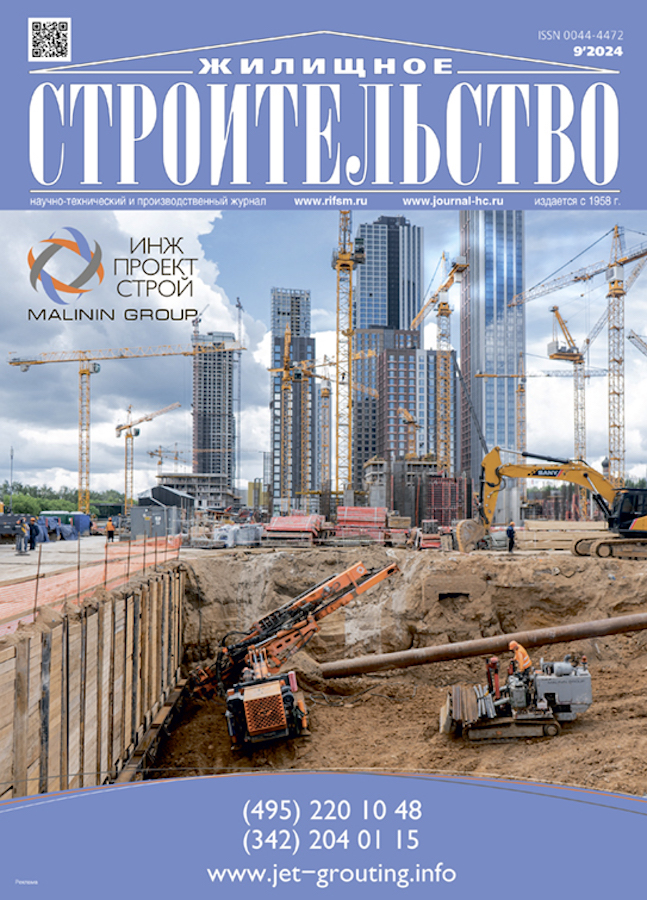Comparison of the Position of the Maximum Humidification Zone when Using the Methods of Stationary and Non-Stationary Heat and Humidity Regime
- Authors: Zubarev K.P.1,2,3
-
Affiliations:
- National Research Moscow State University of Civil Engineering
- Scientific-Research Institute of Building Physics of RAACS
- RUDN University
- Issue: No 9 (2024)
- Pages: 48-52
- Section: Articles
- URL: https://ter-arkhiv.ru/0044-4472/article/view/642656
- DOI: https://doi.org/10.31659/0044-4472-2024-9-48-52
- ID: 642656
Cite item
Abstract
The basic formulas for mathematical modeling of the heat and moisture regime of building envelopes in stationary and non-stationary settings are given. It is noted that the mathematical model uses third kind boundary conditions. Objective of the study: to check whether the moisture maximum plane position in the thickness of building envelopes is confirmed assessing non-stationary moisture conditions. Two methods for verification are used: the graphical method for determining the plane of maximum moisture and the method for assessing the non-stationary moisture regime, based on the Gagarin and Kozlov moisture potential. It was found that the maximum moisture is confirmed both for facade systems with mineral wool insulation and for facade systems with expanded polystyrene insulation. In the case of mineral wool, the maximum moisture is located outside the insulation layer. For expanded polystyrene insulation, the maximum moisture is determined inside the insulation layer. Thus, it was confirmed that the maximum moisture in the thickness of the enclosing structure, determined by the graphical method, is confirmed by mathematical modeling of a non-stationary heat and moisture regime.
Full Text
About the authors
K. P. Zubarev
National Research Moscow State University of Civil Engineering; Scientific-Research Institute of Building Physics of RAACS; RUDN University
Author for correspondence.
Email: zubarevkirill93@mail.ru
Candidate of Sciences (Engineering)
Russian Federation, 26, Yaroslavskoe Highway, Moscow, 129337; 21, Lokomotivniy Driveway, Moscow, 127238; 6, Miklouho-Maclaya Street, Moscow, 117198References
- Lysova E.P., Kotlyarova E.V. Fundamentals of ensuring the environmental safety of building materials at all stages of their life cycle. Sovremennye tendentsii v stroitel’stve, gradostroitel’stve i planirovke territorii. 2023. Vol. 2. No. 2, pp. 72–80. (In Russian). https:// doi.org/10.23947/2949-1835-2023-2-2-72-80
- Samarskaya N.S., Kotlyarova E.V., Lysova E.P. Main scientific principles of a systematic approach to the determination of negative factors affecting urban environment. Bezopasnost’ tekhnogennykh i prirodnykh sistem. 2023. Vol. 7. No. 4, pp. 20–29. (In Russian). https:// doi.org/10.23947/2541-9129-2023-7-4-20-29
- Kotlyarova E. Improving the methodology for assessing the level of environmental safety of urban areas as the basis of their life cycle. E3S Web of Conferences. 2023. Vol. 389. No. 09062. https://doi.org/10.1051/e3sconf/202338909062
- Chernil’nik A., Stel’makh S., Mailyan L., Beskopylny A., Shcherban’ E. The effect of the activation of aggregates with bischofite on the properties of vibrated heavy concrete. Lecture notes in networks and systems. 2023. No. 509. https://doi.org/10.1007/978-3-031-11058-0_135
- Stel’makh S., Mailyan L., Beskopylny A., Shcherban’ E., Shuiskii A. Influence of technological factors of cement mechanical activation on the strength properties of fine-grained concrete. Lecture notes in networks and systems. 2023. No. 510. https:// doi.org/10.1007/978-3-031-11051-1_172
- Mailyan L.R., Stel’makh S.A., Shcherban’ E.M., Smolyanichenko A.S., Efimenko E.A., El’shaeva D.M. Impact of hybrid dispersed reinforcement on strength and stress-strain properties of sand concrete. Processes in GeoMedia. 2023. Vol. VI. https://doi.org/10.1007/978-3-031-16575-7_33
- Graneva A.V., Lushin K.I., Pulyaev I.S., Kudryavtseva V.D. Circular economy in recycling concrete and reinforced concrete waste. Nanotechnologies in сonstruction. 2024. Vol. 16 (1), pp. 50–58. https:// doi.org/10.15828/2075-8545-2024-16-1-50-58
- Lushin K.I., Voitovich E.V. Multimodality of the approach to solving problems of energy efficiency of the urban economic complex. Mezhdunarodnyi technico-economicheskiy zhurnal. 2022. № 5–6, pp. 7–17. (In Russian). https://doi.org/10.34286/1995-4646-2022-86-5/6-7-17
- Lushin K. Improving the method of testing materials for the heat shield of the building. IOP Conference Series: Materials Science and Engineering. 2019. 661 (1). No. 012112.
- Kurasov I.S. Experimental determination of performance indicators of the design of a flat solar collector absorber with artificial secondary surface. Zhilischnoe hozyaistvo i communalnuaya infrastructura. 2023. No. 4 (27), pp. 70–81. (In Russian). https://doi.org/10.36622/VSTU.2023.81.21.007
- Sevryugina N.S., Apatenko A.S. Import substitution and monitoring of workpiece quality. Russian engineering research. 2023. Vol. 43. No. 8, pp. 927–933. https://doi.org/10.3103/s1068798x23080294
- Malozyomov B.V., Martyushev N.V., Kukartsev V.V., Gozbenko V.E., Kondratiev V.V. Determination of the performance characteristics of a traction battery in an electric vehicle. World electric vehicle journal. 2024. Vol. 15 (2). No. 64. https://doi.org/10.3390/wevj15020064
- Sevryugina N.S., Apatenko A.S. Import substitution and monitoring of workpiece quality. Russian engineering research. 2023. Vol. 43 (8), pp. 927–933. https://doi.org/10.3103/S1068798X23080294
- Nemova D., Kotov E., Andreeva D., Khorobrov S., Olshevskiy V., Vasileva I., Zaborova D., Musorina T. Experimental study on the thermal performance of 3D-printed enclosing structures. Energies. 2022. Vol. 15 (12). No. 4230. https://doi.org/10.3390/en15124230
- Musorina T., Gamayunova O., Petrichenko M., Soloveva E. Boundary layer of the wall temperature field. Advances in intelligent systems and computing. 2020. Vol. 1116 AISC, pp. 429–437. https:// doi.org/10.1007/978-3-030-37919-3_42
- Zaborova D.D., Kozinec G.L., Musorina T.A., Petrichenko M.R. Mathematical model for unsteady flow filtration in homogeneous closing dikes. Power technology and engineering. 2020. Vol. 54 (3), pp. 358–364. https:// doi.org/0.1007/s10749-020-01216-9
- Petrichenko M.R., Musorina T.A. Fractional differentiation operation in the Fourier boundary problems. St. Petersburg State polytechnical university journal: physics and mathematics. 2020. Vol. 13 (2), pp. 41–52. https://doi.org/0.18721/JPM.13204
- Statsenko E.A., Musorina T.A., Ostrovaia A.F., Olshevskiy V.Ya., Antuskov A.L. Moisture transport in the ventilated channel with heating by coil. Magazine of Civil Engineering. 2017. No. 70 (2), pp. 11–17. https://doi.org/10.18720/MCE.70.2
- Zubarev K.P. Graphic representations of the calculation of moisture distribution in the building envelope. BCT: Byulleten’ stroitel’noi tekhniki. 2017. No. 6 (994), pp. 78–79. (In Russian).
- Zubarev K.P. Using discrete-continuous approach for the solution of unsteady-state moisture transfer equation for multilayer building walls. International Journal for Computational Civil and Structural Engineering. 2021. Vol. 17. No. 2, pp. 50–57. https:// doi.org/10.22337/2587-9618-2021-17-2-50-57
- Zubarev K.P. Application of the moisture potential theory in assessing the heat and moisture regime of building envelopes. Stroitel’nye Materialy [Construction Materials]. 2024. No. 6, pp. 46–51. (In Russian). https://doi.org/10.31659/0585-430X-2024-825-6-46-51
Supplementary files

















